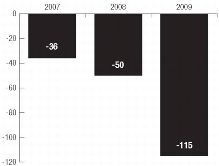Home >Financials >
2009 Annual Report - The Challenge to Deliver >
MANAGEMENT’S DISCUSSION ANDANALYSIS OF FINANCIAL CONDITIONAND RESULTS OF OPERATIONS > WORKHOURS
The unprecedented 115 million, or 8.4%, decrease in 2009 workhours resulted in large part from lower mail volumes. Management initiatives and delivery route adjustments, initiated in response to the decline in workload, contributed further reductions. Workhours decreased in all major functions. The 2009 reductions were in addition to the 50 million hour reduction from the prior year. In 2009, mail processing used 42 million fewer hours than the prior year. City and rural delivery hours were less than 2008 by 28 million and 9 million hours, respectively. Customer service and retail hours were down 26 million workhours from the prior year. The other workhour category decreased by 10 million hours. Contributing to the overall workhour reduction was the continuing close scrutiny of overtime usage which resulted in a reduction of 35.7%, or 36 million, overtime hours. The overtime ratio to total workhours was 5.1% in 2009, as compared with 7.3% for 2008.
Workhours by Function (workhours in thousands)
|
2009
|
2008
|
2007
|
City Delivery
|
424,683
|
452,288
|
462,040
|
Mail Processing
|
251,200
|
293,108
|
315,825
|
Customer Services & Retail
|
190,749
|
217,236
|
233,791
|
Rural Delivery
|
181,090
|
189,950
|
189,709
|
Other, Including Plant, Operational Support, and Administrative
|
210,303
|
220,772
|
221,636
|
Total Workhours
|
1,258,025
|
1,373,354
|
1,423,001
|
Rural delivery hours decreased in 2009 despite the addition of over 600,000 new rural delivery points. Rural carrier workhour reductions were driven primarily by the mail count evaluations that were implemented in April 2009. These mail counts reduced weekly rural carrier evaluated workhours by 154,000 hours, or 4.3%, per week. This change directly reflected the reduction in mail volume from the previous year. The total number of new delivery points was also dramatically lower in 2009 and is a direct reflection of the weak economy, with lower housing starts and housing sales.
Workhour Reductions (hours in millions)

In 2008, total workhours decreased by 50 million hours compared to 2007, partially offsetting higher labor rates. Mail processing, customer service and city delivery workhours collectively decreased by 50 million. Rural delivery increased 0.2 million workhours in 2008, driven by the addition of almost 710,000 new rural delivery points.
Workhours have been reduced in nine of the last ten years, with only 2005 showing a slight increase. Since 2002, workhour reductions have been the single biggest contributor to the ongoing achievement of savings targets.
|
